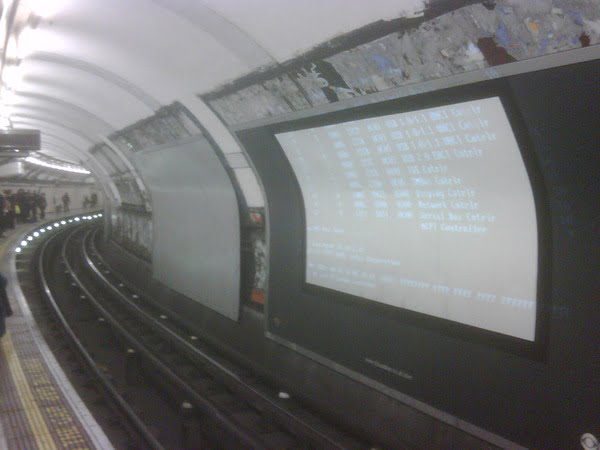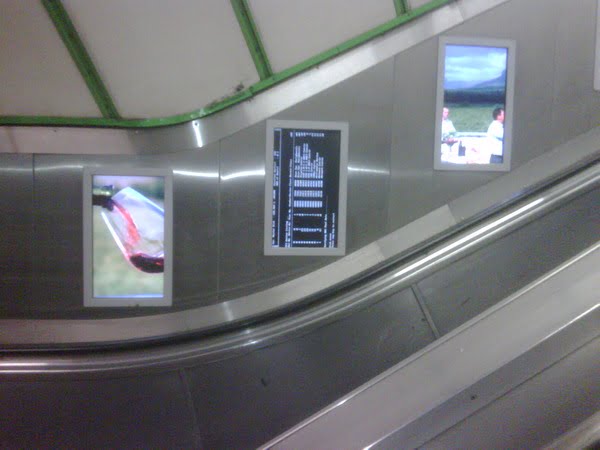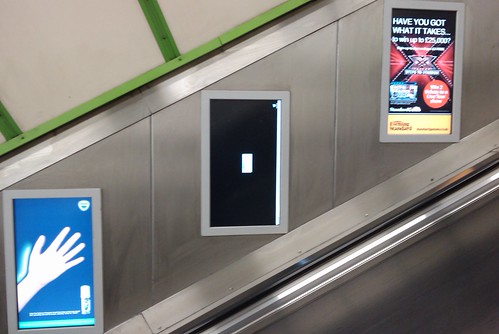Microsoft's New Marketing Campaign
I wander around the world in a perpetual state of confusion. Why is the world the way it is? Why do people make bad decisions? Why - when there are so many better alternatives - do people choose the worst of all possible worlds?
Rather than getting bogged down in philosophy, I refer to the reason people choose Microsoft Windows to do anything public facing.
Advertisers obviously care enough about their message to craft 30 second videos, they invest millions on infrastructure to support showing them. Then they take a totally unsuitable and unstable method for playing them back - why?
It's a phenomena I repeatedly see. Advertising screens around the world which are really only displaying one message.
They're saying "Windows - The Worst Way To Get Your Message Across".
However, it's not just Windows which has the problem - each of these three photos show a PC which has failed to POST correctly. So they are stuck - forever displaying their inadequacies to thousands of passers-by. (Click to embiggen)



My real rant isn't about Windows - it's about the design and thinking behind such advertising screens. It would appear that each screen is driven by its own PC. What madness! The cost of hardware - let alone software - must be phenomenal.
At the moment, each screen displays exactly the same content as its neighbour. There's no reason why a single computer couldn't be used to drive all the screens.
I say exactly the same - the screens get progressively out of sync as the day goes on. Presumably the separate PCs don't communicate with one and other.
The next thing that bothers me is the use of Windows.
These screens aren't using an embedded version of Windows - they're using XP. Now, XP is a fine OS - but it is bloated in terms of what is needed. All that is needed is a small embedded device which can be loaded with video files and set to play back.
It doesn't need a desktop OS. It doesn't need anything more complicated than a display, video codecs and an Ethernet port. This is the sort of thing for which Linux is perfect.
So, why? Why has this system been allowed to develop? Every day I see another screen which is broken, out of sync, or crashed. Why has such a fragile and expensive solution become so prevalent?
The majority of these photos show TFL advertising screens managed by CBS Outdoor. I really do wonder if they ever wander through the tube and see what a shoddy experience they are delivering.







The why part is easy. Stupid people know Windows. They drag and drop files onto it and it copies. Job done.
Any IT department can ghost an image onto a computer. Job done.
Clever people know that a small amount of prep time - getting a working linux image and a cron job to fetch video packs - will save them a lot of headache in the long run, but Linux, or NetBSD, or FreeBSD, or OpenBSD, or any of the others are all too niche. Too unknown for non-technical people.
While the entry requirement on knowledge is falling - and the average user (as opposed to developer or enthusiast) intelligence of the open source software world is dropping as a result, the usability hasn't proceeded at the same rate and the intelligence needed for average companies is still too high.
To be fair, there used to be quite a nifty version of Windows for embedded use. Not evident that this is being used here, of course... but it may not be a full desktop system.
Actually, using a mobile OS might not be a foolish idea: in the future I could imagine that these ads might interact with the individual passing them on the escalator, Minority-Report-style, and peering might be more reliable if you've got Android at both ends. Ha! 🙂
As a previous commenter pointed out "people know windows". In a previous life I worked with Point of Sales software for a multinational, and while both linux and windows systems were offered people invariable chose windows - the reasons were all different but always boiled down to the "Nobody gets fired for buying IBM" argument (or in this case Microsoft).
As for the hardware, I agree with you that the one machine per screen setup is inefficient, but while it is not the best technical decision it may be the best business decision. Almost certainly the computer running the screen is built into the screen assembly itself making a simple unit which can be sold as a scalable commodity that which can be shipped and wired up by relatively unskilled labour.
Additionally having all the machines running off a central machine would present a single point of failure - instead of one broken screen, 100 could show a BSOD on a failure or worse...
I would be surprised if there wasn't a central update facility, but that said the prospect of some nasty cracker putting something on all the TFL screens would be enough to scare most managers (who would have their jobs on the line) and enough to push a fat support contract to TFL and the advertisers which is where a lot of these guys make their money anyway.